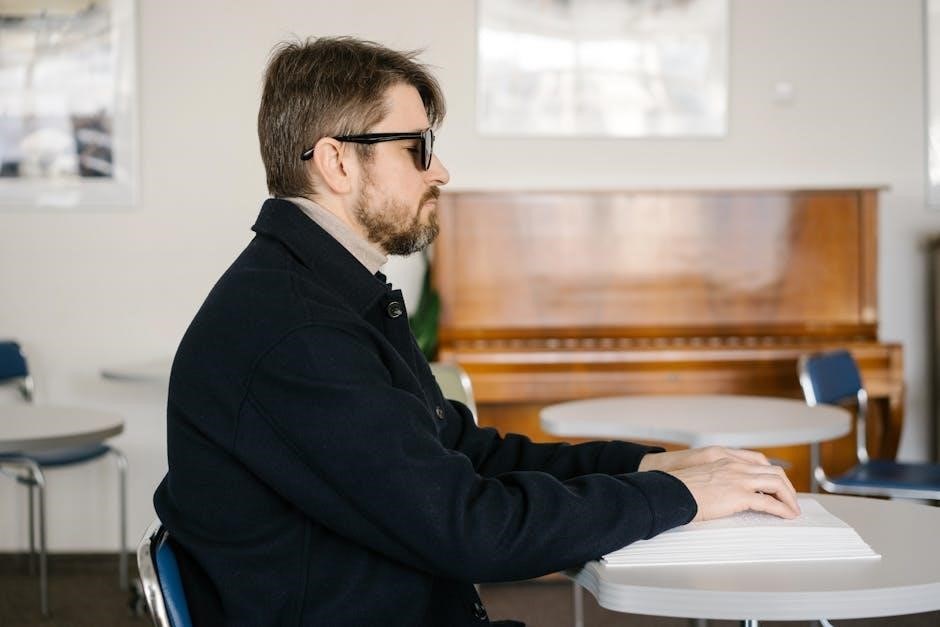
Guiding Eyes for the Blind is a nonprofit organization based in Patterson, NY, dedicated to providing exceptional guide dogs to individuals with vision loss. Since its founding, it has trained over 10,000 guide dogs, focusing on careful matching to ensure compatibility with recipients’ needs. The organization operates a 30-acre Canine Development Center in Patterson, equipped with state-of-the-art facilities, including a full-service veterinary hospital and indoor/outdoor recreation areas. Guiding Eyes relies on a network of volunteers for puppy raising and offers extensive support, including weekly obedience classes and local assistance.
1.1 Mission and Vision
Guiding Eyes for the Blind is driven by a mission to empower individuals with vision loss by providing exceptional guide dogs, free of charge. Their vision is to create a world where everyone with visual impairment can live independently and confidently. By carefully matching dogs to recipients based on lifestyle, needs, and preferences, Guiding Eyes ensures life-changing partnerships. The organization prioritizes accessibility, offering extensive support services, including training, veterinary care, and ongoing assistance. With a focus on innovation and compassion, Guiding Eyes aims to expand its reach and improve the lives of those in need, fostering a culture of inclusion and empowerment for all.
1.2 History and Milestones
Guiding Eyes for the Blind was founded in 1954 with the goal of providing guide dogs to individuals with vision loss. Over the years, the organization has achieved remarkable milestones, including training over 10,000 guide dogs. The establishment of the Patterson Canine Development Center marked a significant expansion, enabling advanced breeding, socialization, and training programs. Guiding Eyes was the first guide dog school to prioritize genetic diversity and behavioral studies in its breeding program, ensuring healthier, more resilient dogs. The organization has also expanded its facilities, including state-of-the-art kennels and a full-service veterinary hospital. These advancements reflect Guiding Eyes’ commitment to innovation and excellence in service to those with vision loss. Its history underscores a dedication to transforming lives through exceptional guide dogs and unwavering support.

The Role of the Patterson Canine Development Center
The Patterson Canine Development Center is a 30-acre campus dedicated to breeding, socializing, and early training of future guide dogs. It houses state-of-the-art kennels, a veterinary hospital, and outdoor recreational spaces, fostering a nurturing environment for puppies and their development.
2.1 Facilities and Resources
The Patterson Canine Development Center boasts a 30-acre campus equipped with modern facilities to support the breeding, socialization, and care of guide dogs. The center features state-of-the-art kennels, a full-service veterinary hospital, and indoor/outdoor recreational spaces designed to promote the health and well-being of the dogs. Additionally, the facility includes specialized areas for puppy socialization and training, ensuring a nurturing environment for early development. These resources enable the organization to provide exceptional care and lay the foundation for raising confident, capable guide dogs;
- 30-acre campus with modern kennels
- Full-service veterinary hospital
- Indoor and outdoor recreation areas
- Specialized spaces for socialization and training
2.2 Breeding and Socialization Programs
Guiding Eyes for the Blind operates a robust breeding program at its Patterson facility, focusing on producing dogs with the ideal traits for guide work. The program carefully selects and breeds dogs based on temperament, intelligence, and physical characteristics. From an early age, puppies are socialized in nurturing environments to ensure they develop confidence and calmness in various settings. Volunteers play a crucial role by welcoming litters into their homes shortly after birth, providing care and initial socialization for 2 to 5 weeks. This early exposure helps prepare the puppies for advanced training and their future roles as guide dogs.
- Selective breeding for ideal guide dog traits
- Puppies socialized from birth
- Volunteers provide early care and nurturing
- Foundation for future guide dog success

Training Process for Guide Dogs
Guiding Eyes’ training involves socialization, obedience, and public access preparation, ensuring dogs adapt to various environments. Advanced training refines skills, focusing on clear communication and reliability for visually impaired individuals.
3.1 Puppy Raising Program
Guiding Eyes for the Blind’s Puppy Raising Program is a cornerstone of their training process. Volunteers take home 8-week-old puppies and nurture them for about a year, teaching basic obedience and socialization. The program focuses on exposing puppies to diverse environments, people, and experiences to build confidence and adaptability. Puppy raisers receive guidance through classes, online resources, and local support groups to ensure consistent training. The goal is to lay a strong foundation for advanced training. This phase is critical, as it shapes the puppy’s behavior and prepares them for their future role as guide dogs. The bond between raisers and puppies is profound, though bittersweet, as they eventually return for formal training. This program relies on the dedication of volunteers who play a vital role in the journey of these future guide dogs.
3.2 Advanced Training Techniques
Guiding Eyes for the Blind employs advanced training techniques to prepare dogs for their roles as guide dogs. After the puppy raising phase, dogs enter formal training at the Canine Development Center in Patterson. Trainers use positive reinforcement methods to teach complex commands and navigation skills. Dogs learn to avoid obstacles, stop at curbs, and respond to traffic signals. Public access training ensures they behave calmly in crowded spaces. The training lasts 4-6 months, focusing on precision and reliability. Each dog is matched with a handler based on specific needs, such as gait, strength, and lifestyle. The organization also operates a training site in White Plains for this phase. These techniques ensure dogs are fully prepared to assist individuals with vision loss, providing independence and confidence. The advanced training phase is crucial in transforming puppies into life-changing guide dogs.

Volunteer Opportunities and Community Involvement
Guiding Eyes for the Blind offers diverse volunteer opportunities, including puppy raising and local chapter involvement. Volunteers play a crucial role in nurturing future guide dogs and supporting their community.
4.1 Puppy Raisers and Their Contributions
Puppy raisers play a vital role at Guiding Eyes for the Blind, nurturing future guide dogs from an early age. These volunteers welcome puppies into their homes, typically within a week of birth, and care for them for 2 to 5 weeks. During this time, they focus on socialization, teaching basic obedience, and helping the puppies develop confidence. Puppy raisers also provide emotional support, creating a strong foundation for the dogs’ future training. Their contributions are essential to the success of Guiding Eyes’ mission, as they lay the groundwork for the dogs to become reliable guide dogs. The organization offers extensive support to puppy raisers, including weekly obedience classes, free veterinary care, and local assistance, ensuring both the volunteers and puppies thrive in this critical phase of development.
4.2 Local Chapters and Events
Guiding Eyes for the Blind fosters community engagement through local chapters and events, strengthening connections and raising awareness about guide dogs. These chapters, such as the emerging Western Maine chapter, organize activities to support puppy raisers and promote the organization’s mission. Events like National Puppy Day celebrations at the Patterson Canine Development Center highlight the importance of early socialization and training. Additionally, Guiding Eyes collaborates with local groups, such as the Kiwanis Club, to educate the public about the role of guide dogs. These initiatives not only build a supportive network but also inspire others to get involved, whether through volunteering or spreading the word about the life-changing impact of guide dogs.

The Impact of Guiding Eyes for the Blind
Guiding Eyes for the Blind transforms lives by providing exceptional guide dogs to individuals with vision loss, fostering independence and confidence through their comprehensive training and support programs.
5.1 Success Stories and Testimonials
Guiding Eyes for the Blind has transformed countless lives through its exceptional guide dogs. Recipients often share heartfelt stories of how their dogs have restored independence and confidence. For instance, individuals like Joshua Cicchino highlight how their guide dogs navigate bustling streets, climb stairs, and adapt to unique environments. Volunteers, such as Martin and her family, who have raised puppies for five years, emphasize the joy of contributing to life-changing partnerships. Testimonials frequently mention the seamless matching process, where dogs are carefully paired with recipients based on lifestyle and needs. These success stories illustrate the profound impact of Guiding Eyes, not only in providing mobility but also in fostering emotional connections and empowerment for individuals with vision loss.
5.2 Expanding Access to Guide Dogs
Guiding Eyes for the Blind is committed to expanding access to guide dogs for individuals with vision loss. The organization has recently expanded its facilities in Patterson, NY, to accommodate growing demand and improve its breeding and training programs. Efforts to establish local chapters, such as the Western Maine chapter, aim to increase outreach and support for potential recipients. By recruiting more volunteers and puppy raisers, Guiding Eyes ensures that more people can benefit from its life-changing services. The organization also prioritizes providing guide dogs at no cost to recipients, making its programs accessible to a broader audience. This expansion enables Guiding Eyes to meet the rising need for guide dogs, driven by increasing rates of vision loss due to conditions like diabetes. These initiatives underscore the organization’s dedication to empowering individuals nationwide.